Dental Implant Process – Houston, TX
Everything You Need to Know About Dental Implant Tooth Replacement
Getting a dental implant isn’t like getting a filling. It isn’t a process that can be completed in just one visit. There are multiple steps you’ll need to complete, and our team at Piney Point Dental Implant Center will be by your side during each and every single one. The dental implant process with our Houston, TX oral surgeon might be slightly different for some patients depending on their needs, but normally you can expect the following to happen when you replace your teeth with dental implants.
Step 1: Initial Consultation
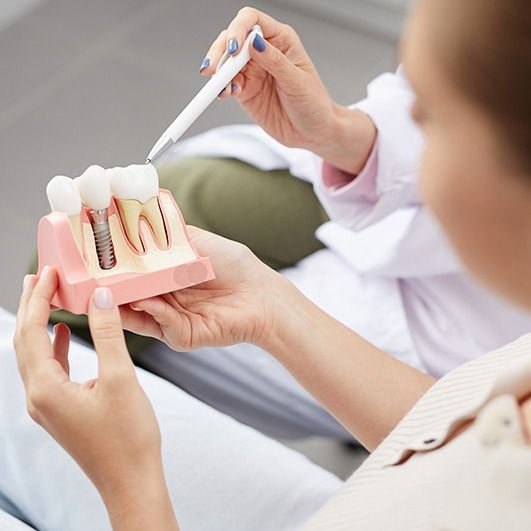
When you decide to get dental implants to replace your missing teeth, the entire process begins with a simple phone call. All you need to do is contact Piney Point Dental Implant Center, and our friendly team will schedule you for an initial consultation. This appointment will give you a chance to ask any questions that you like, plus your Houston oral surgeon will be able to tell you if you are a good candidate for the treatment or not.
In the dental office, once you’ve had time to meet and get to know one of our two Houston oral surgeons, either Dr. Koo or Dr. Weil, they’ll start by thoroughly examining your mouth and taking a variety of X-ray images. With this information, they’ll begin to lay out a plan for your implant surgery and help you decide which type of restoration is best for you.
They’ll also be able to tell you if you need any preparatory procedures before you can have implants placed. If you have any ongoing oral or overall health issues (such as cavities, gum disease, uncontrolled diabetes, etc.), these will need to be addressed before the implant procedure can be performed. They may also suggest that you undergo a bone graft if your jawbone is too thin or brittle to securely hold implants as is. Should you need one, we can take care of it right here at Piney Point Dental Implant Center.
Once you have gone over and approved your plan with the oral surgeon, you’ll then have a chance to work out the financial details, whether that entails using insurance and/or monthly financing.
Step 2: Dental Implant Placement
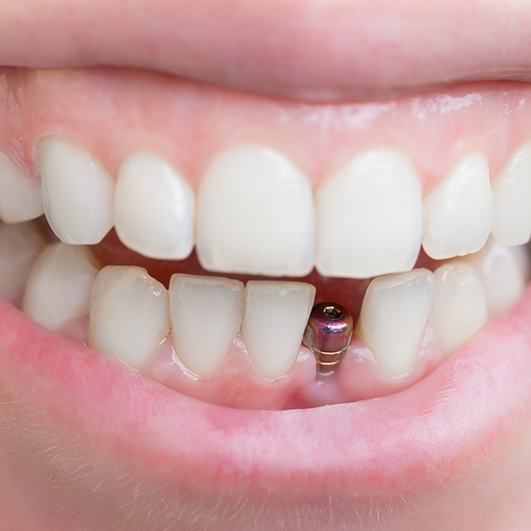
After any necessary preparatory procedures have been completed, you’ll be scheduled for implant placement surgery. This will be carried out in our dental office, and we’ll use local anesthesia and/or IV sedation to ensure your comfort the entire time.
After numbing you, your oral surgeon will make a small incision in your gums to expose the area of your jawbone where your tooth has gone missing. They will then create a small hole in the bone to fit the implant, position the post within the bone, and then they’ll close the treatment site using self-dissolving stitches.
We strive to make this part of the process as painless as possible, and our patients typically report feeling very little discomfort either during or after their procedure. Most are able to go back to work the very next day. Some swelling, bruising, and minor bleeding is to be expected for a couple of days afterward, but these can usually be managed with over-the-counter medications.
Step 3: Osseointegration
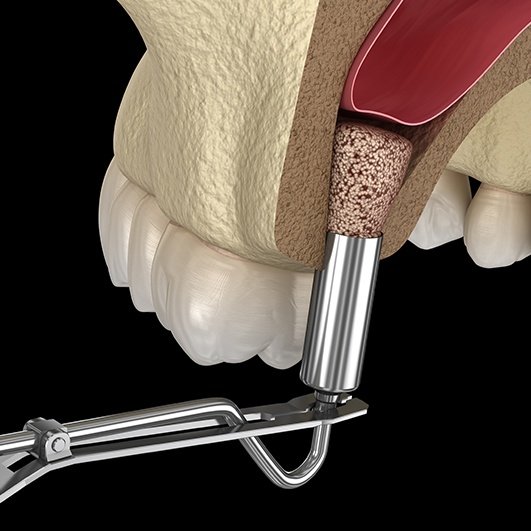
At this point, you’ll be given a few months to heal. Your gums will heal in about seven days, so most of this time is actually dedicated to giving the dental implants the opportunity to bond with the surrounding jawbone. This process is called osseointegration, and it enables your dental implants to provide a strong and steadfast foundation for your new teeth.
During this healing period, you’ll be able to go on with your normal life, as you will have been fitted with a temporary restoration. You’ll need to stick to a soft food diet for the first few weeks to make sure your implants have time to heal properly. Overall, this part of the process can take about three to six months depending on a patient’s particular situation.
Step 4: Abutment Placement
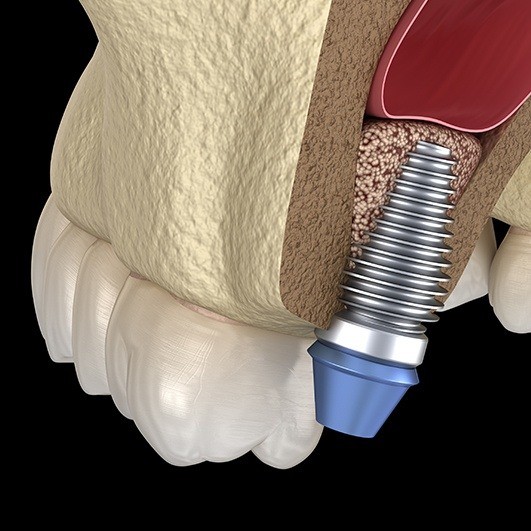
Once your oral surgeon is satisfied with how your implants have bonded to your jawbone, a small connector called an abutment will be placed on each individual implant post just above your gum line. For some, the abutments can be placed at the same appointment as their implants. You’ll then be given a few weeks so your gums can heal.
Step 5: Dental Implant Restoration
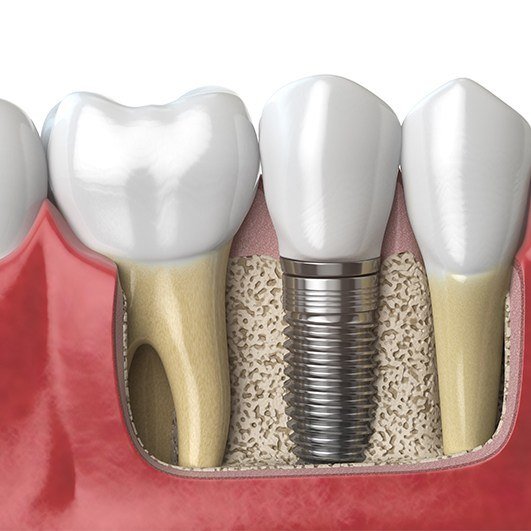
After your gums have fully healed, now comes the fun part where you’re actually ready to receive your new teeth. Your implant dentist will take multiple impressions of your mouth and remaining teeth, so they can custom-design a prosthetic to fit seamlessly into your smile. This could consist of an individual dental crown, implant-supported fixed bridge, or a denture.
Your impressions will be sent to a dental lab to fabricate your new teeth, and after a couple of weeks, you’ll return to our oral surgery office to have them attached to your implants using the abutments. After checking their fit and making sure your bite is properly aligned, your new smile will finally be complete!
Step 6: Periodic Dental Checkups
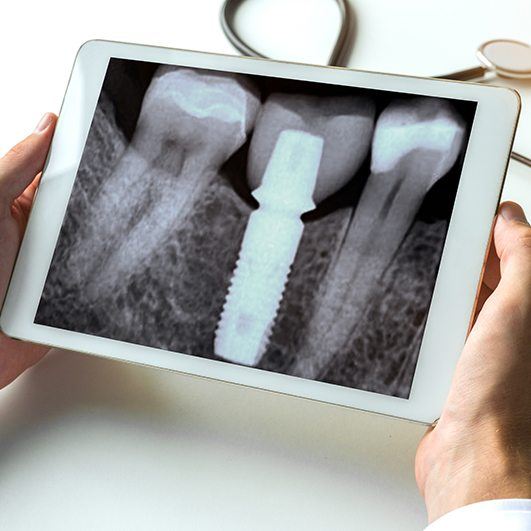
Even though dental implants themselves cannot develop decay or cavities, you will still need to take care of them like your natural teeth in order to maintain them, which involves consistent brushing, flossing, and regular dental checkups. Without a solid oral hygiene routine, the gums and bone near the implants can actually develop an infection that compromises their stability. Also, if you are prone to nighttime teeth grinding (bruxism), it is highly recommended that you wear a nightguard to bed in order to not accidentally damage your restorations. You can get one custom-made from your dentist if necessary.
With the proper maintenance, dental implants can easily look and feel like new for 30 years or more. The restorations above the gum line may need to be replaced every decade or so, but their longevity will largely depend on how well you take care of them.
From beginning to end, this entire process can take about three to nine months. Simpler cases involving a smaller number of implants and a healthy jawbone will take less time, while those that require multiple preparatory procedures and involve numerous posts will take longer.
While this is generally how the implant process works, it is always a little different for each individual patient. The best way to find out how your particular implant journey will go is simply to schedule a consultation here at Piney Point Dental Implant Center. Starting at this appointment, we’ll be with you every step of the way, and it's just a matter of time before you’ll have a full and confident smile to enjoy once again.
To learn more about dental implants, the process, or to schedule a consultation, contact us today.

